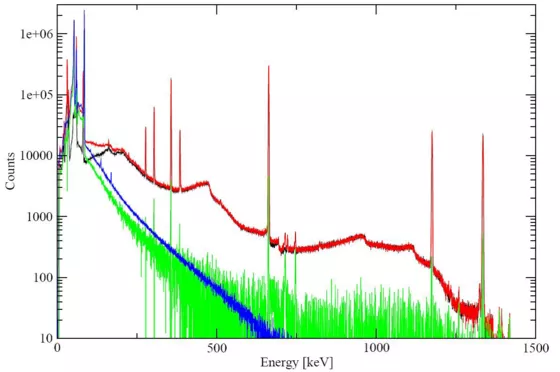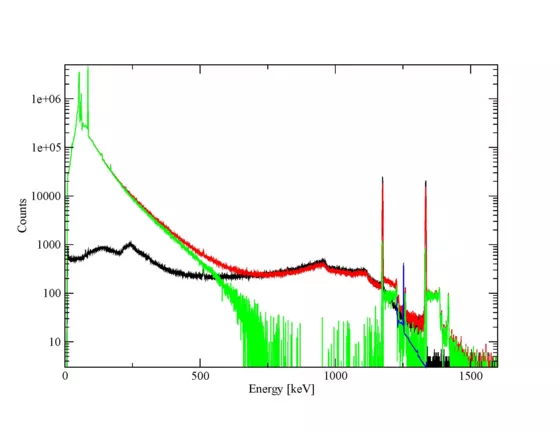Nutzung von Bremsstrahlungsinformationen für die zerstörungsfreie Charakterisierung radioaktiver Abfälle
Projektleiter: Dr. Thomas Bücherl
Wissenschaftler: Dipl. Phys. Benjamin Rohrmoser
In Kooperation mit TU München, Physikdepartment, E 21, Prof. P. Böni
Das Vorhaben wurde mit Mitteln des Bundesministeriums für Bildung und Forschung unter dem Förderkennzeichen 02S8669 gefördert.
Mit der Machbarkeitsstudie konnte gezeigt werden, dass in γ-Messungen radioaktiver Abfallgebinde eine Identifikation von β-Strahlern aus den γ-Spektren anhand ihrer Bremsstrahlungsbeiträge prinzipiell möglich ist. Hierfür wurde ein sechs-stufiges Auswerteverfahren erarbeitet und manuell getestet.
In verschiedenen Untersuchungen wurden unter anderem drei wesentliche Bestandteile des Verfahrens untersucht. Hierbei zeigte sich, dass die Extraktion der Bremsstrahlungsbeiträge aus gemessenen γ-Spektren unter gewissen Randbedingungen (wie z. B. der Kenntnis des Spektrums, das von den enthaltenen γ-Strahlern erzeugt wird, des Untergrunds etc.) prinzipiell möglich ist. Dieses extrahierte Spektrum ist bezüglich der schwächenden Eigenschaften der Materialien zu korrigieren, die sich zwischen dem Ort des β-Strahlers und dem Detektor befinden. Die prinzipielle Durchführbarkeit dieser Korrektur wurde ebenfalls aufgezeigt. Für die praktische Anwendung dieses Auswerteverfahrens ist die Simulation des Spektrums, das von den in der Messung identifizierten γ-Strahlern erzeugt wird, von entscheidender Bedeutung. Durchgeführte Untersuchungen zeigten auch hier die prinzipielle Machbarkeit, zeigten jedoch auch noch deutlichen Verbesserungsbedarf auf diesem Gebiet auf.
Die praktische Umsetzung des Auswerteverfahrens erfordert weitere Entwicklungsarbeiten, speziell im Hinblick auf eine automatisierte Umsetzung. In den einzelnen Schritten des Auswerteverfahrens wurden Punkte identifiziert, die hierfür weitergehend untersucht werden müssen. Das Fernziel einer Auswertung von γ-Spektren hinsichtlich der in ihnen enthaltenen β-Strahler ist die Quantifizierung dieser Strahler. Hierfür wurden bei RCM erste weitergehende Untersuchungen mit einem mathematischen Modell durchgeführt, welches den Zusammenhang zwischen β-Strahler und dessen Beitrag im gemessenen γ-Spektrum beschreibt. Hierbei wurden bereits zahlreiche noch zu lösende Fragestellungen ermittelt.
Unterstützt wird das Verfahren durch eine Liste potentieller β-Strahler, die bei einer γ-Messung eines realen Gebindes mit radioaktivem Abfall auftreten können. Anhand spezifischer Kriterien konnte hier eine Reduzierung auf wenige jeweils in Frage kommende Nuklide erreicht werden.

Figure 1: Black: Spectrum of the gamma-emitters 60Co, 133Ba, 137Cs, 241Am; Red: Spectrum of the gamma-emitters 60Co, 133Ba, 137Cs, 241Am and 170Tm; Blue: Spectrum of 170Tm (identical to the difference of the red and black spectra (Green))
As a first result, it was demonstrated that in this simple set-up the extraction of the Bremsstrahlung-part from different gamma-emitters is possible. In a second experiment with 170Tm-samples of different activities the limits of the method were investigated, i.e. the minimum activity of the beta-emitter required for definite identification in dependence of the activities of the gamma-emitters being present. This value is defined as beta-to-gamma ratio. Figure 2 shows the spectra of 60Co (3.0·104 Bq) and 60Co together with 170Tm (5.7·107 Bq). In the spectrum of 60Co and 170Tm shoulders on the right hand side of the characteristic gamma-peaks of 60Co at 1173.3 and 1332.5 keV are noticeable, not being present in the spectrum of only 60Co. The only explanation is a contribution by 170Tm having an endpoint energy of about 970 keV. This becomes clear in figure 2, which also shows the difference of the two measured spectra. Up to about 700 keV the characteristics of the pure 170Tm is visible. Between 1100 keV and 1500 keV also summation effects take place, as well known in pure gamma-spectroscopy [2]. The peaks at 1257 keV and 1418 keV, respectively, are the results of the summations of the two cobalt peaks with the only thulium peak at 84.3 keV. In figure 2, the pure 170Tm spectrum is added to the right side of the 1173.3 keV 60Co peak for better illustration. It indicates the trend of the 170Tm spectrum between 60 - 200 keV, thus reflecting the summation effect. These shoulders might be used for the determination of Bremsstrahlung-emitters in the future. In this case the beta-to-gamma-ratio has an extremely high value of about 2000.

Figure 2: Black: 60Co spectrum, Red: spectrum of 60Co with 170Tm. Green: Difference-spectrum of 60Co and 170T measured together minus the 60Co only spectrum. Blue: The energy range from 60 - 200 keV of the 170Tm spectrum is added to the right side of the 1173.3 keV 60Co peak for better illustration.
The experiment was repeated with 170Tm (2.8·106 Bq) and 137Cs (2.3·105 Bq). Here the beta-to-gamma- ratio is only about 12. Converted with the use of the their decay constants, the number of cesium-atoms was seven times bigger than the number of thulium-atoms. The problem here is, that the 661.7 keV Cs-peak occurs within the 170Tm-spectrum. However the same effect as discussed above for 60Co is still distinguishable, although less distinctive. The appearance of these summation effects may simplify the search for beta-emitters in radioactive waste matrices. Additional experiments as well as computer simulations will be performed to demonstrate the applicability of this method in practice. Special focus will be given on the influence of absorbing matrices surrounding the gamma- and beta-emitters.
References
[1] A. S. Dhaliwal, S. Amarjit Nucl. Instrum. and Methods B 198:32-36, 2002.
[2] G. Gilmore, J. Hemingway Practical Gamma-ray Spectroscopy, John Wiley and Sons, 1995.